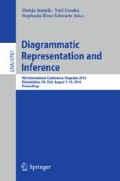Abstract
This paper presents a taxonomy of 19 cognitive criteria for judging what constitutes effective representational systems, particularly for knowledge rich topics. Two classes of cognitive criteria are discussed. The first concerns access to concepts by reading and making inferences from external representations. The second class addresses the generation and manipulation of external representations to fulfill reasoning or problem solving goals. Suggestions for the use of the classification are made. Examples of conventional representations and Law Encoding Diagrams for the conceptual challenging topic of particle collisions are provided throughout.
Access this chapter
Tax calculation will be finalised at checkout
Purchases are for personal use only
References
Barwise, J., Etchemendy, J.: Heterogeneous logic. In: Glasgow, J., Narayanan, N.H., Chandrasekaran, B. (eds.) Diagrammatic Reasoning: Cognitive and Computational Perspectives, pp. 211–234. AAAI Press, Cambridge (1995)
Cheng, P.C.-H.: Problem solving and learning with diagrammatic representations. In: Peterson, D. (ed.) Forms of Representation, pp. 47–66. Intellect Books, Bristol (1996)
Cheng, P.C.-H.: Learning qualitative relations in physics with Law Encoding Diagrams. In: Cottrell, G.W. (ed.) Proceedings of the Eighteenth Annual Conference of the Cognitive Science Society, pp. 512–517. Lawrence Erlbaum (1996)
Cheng, P.C.-H.: Interactive law encoding diagrams for learning and instruction. Learn. Instr. 9(4), 309–326 (1999)
Cheng, P.C.-H.: Unlocking conceptual learning in mathematics and science with effective representational systems. Comput. Educ. 33(2–3), 109–130 (1999)
Cheng, P.C.-H.: Electrifying diagrams for learning: principles for effective representational systems. Cogn. Sci. 26(6), 685–736 (2002)
Cheng, P.C.-H.: Why diagrams are (sometimes) six times easier than words: benefits beyond locational indexing. In: Blackwell, A.F., Marriott, K., Shimojima, A. (eds.) Diagrams 2004. LNCS (LNAI), vol. 2980. Springer, Heidelberg (2004)
Cheng, P.C.-H.: Probably good diagrams for learning: representational epistemic re-codification of probability theory. Topics Cogn. Sci. 3(3), 475–498 (2011)
Cheng, P.C.-H.: Algebra diagrams: a HANDi introduction. In: Cox, P., Plimmer, B., Rodgers, P. (eds.) Diagrams 2012. LNCS, vol. 7352, pp. 178–192. Springer, Heidelberg (2012)
Cheng, P.C.-H., Barone, R.: Representing complex problems: a representational epistemic approach. In: Jonassen, D.H. (ed.) Learning to Solve Complex Scientific Problems, pp. 97–130. Lawrence Erlbaum Associates, London (2007)
Cheng, P.C.-H., Barone, R., Cowling, P.I., Ahmadi, S.: Opening the information bottleneck in complex scheduling problems with a novel representation: STARK diagrams. In: Hegarty, M., Meyer, B., Narayanan, N. (eds.) Diagrams 2002. LNCS (LNAI), vol. 2317, pp. 264–278. Springer, Heidelberg (2002)
Cheng, P.C.-H., Simon, H.A.: Scientific discovery and creative reasoning with diagrams. In: Smith, S., Ward, T., Finke, R. (eds.) The Creative Cognition Approach, pp. 205–228. MIT Press, Cambridge (1995)
Cosmides, L., Tooby, J.: Are humans good intuitive statisticians after all? Rethinking some conclusions from the literature on judgment under uncertainty. Cognition 58, 1–73 (1996)
Cleveland, W.S., McGill, R.: Graphical perception and graphical methods for analysing scientific data. Science 229, 828–833 (1985)
Engelhardt, J.: The language of graphics. ILLC, University of Amsterdam (2002)
Green, T., Blackwell, A.: Cognitive Dimensions of Information Artefacts: a tutorial. https://www.cl.cam.ac.uk/~afb21/CognitiveDimensions/CDtutorial.pdf
Gurr, C.A.: On the isomorphism, or lack of it, of representations. In: Marriott, K., Meyer, B. (eds.) Visual Language Theory, pp. 293–306. Springer, Heidelberg (1998)
Hoffman, D.D.: Visual Intelligence: How We Create What We See. WW Norton & Company, New York (2000)
Koedinger, K.R., Anderson, J.R.: Abstract planning and perceptual chunks: elements of expertise in geometry. Cogn. Sci. 14, 511–550 (1990)
Kotovsky, K., Hayes, J.R., Simon, H.A.: Why are some problems hard? Cogn. Psychol. 17, 248–294 (1985)
Larkin, J.H., Simon, H.A.: Why a diagram is (sometimes) worth ten thousand words. Cogn. Sci. 11, 65–99 (1987)
Markman, A.B.: Knowledge Representation. Lawrence Erlbaum, London (1999)
Newell, A., Simon, H.A.: Human Problem Solving. Prentice-Hall, Englewood Cliffs (1972)
Peebles, D.J., Cheng, P.C.-H.: Modelling the effect of task and graphical representations on response latencies in a graph-reading task. Hum. Factors 45(1), 28–45 (2003)
Scaife, M., Rogers, Y.: External cognition: how do graphical representations work? Int. J. Hum. Comput. Stud. 45, 185–213 (1996)
Shimojima, A.: Semantic Properties of Diagrams and Their Cognitive Potentials. CSLI Press, Stanford (2015)
Stenning, K., Oberlander, J.: A cognitive theory of graphical and linguistic reasoning: logic and implementation. Cogn. Sci. 19(1), 97–140 (1995)
Stillings, N.A., Weisler, S.E., Chase, C.H., Feinstein, M.H., Garfield, J.L., Rissland, E.L.: Cognitive Science: An Introduction, 2nd edn. MIT Press, Cambridge (1995)
Tversky, B.: Visualizing thought. Top. Cogn. Sci. 3, 499–535 (2011)
Zhang, J., Norman, D.A.: Representations in distributed cognition tasks. Cogn. Sci. 18(1), 87–122 (1994)
Author information
Authors and Affiliations
Corresponding author
Editor information
Editors and Affiliations
Rights and permissions
Copyright information
© 2016 Springer International Publishing Switzerland
About this paper
Cite this paper
Cheng, P.CH. (2016). What Constitutes an Effective Representation?. In: Jamnik, M., Uesaka, Y., Elzer Schwartz, S. (eds) Diagrammatic Representation and Inference. Diagrams 2016. Lecture Notes in Computer Science(), vol 9781. Springer, Cham. https://doi.org/10.1007/978-3-319-42333-3_2
Download citation
DOI: https://doi.org/10.1007/978-3-319-42333-3_2
Published:
Publisher Name: Springer, Cham
Print ISBN: 978-3-319-42332-6
Online ISBN: 978-3-319-42333-3
eBook Packages: Computer ScienceComputer Science (R0)

